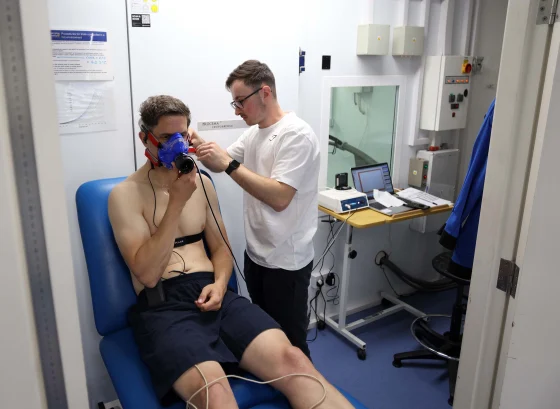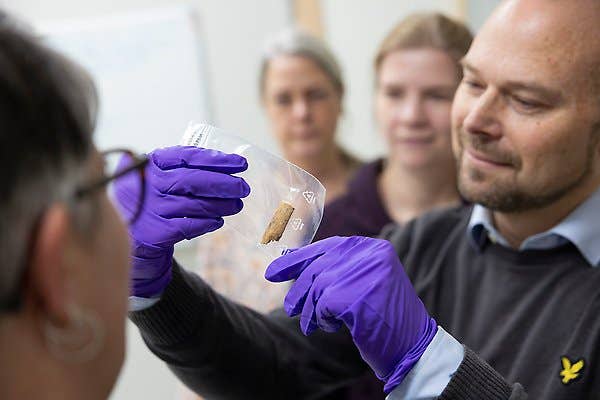How hot is ‘too hot’ for humans? Groundbreaking research finds our limits
University of Roehampton research has discovered the existence of an ‘upper critical temperature’ for humans a previously uncharted realm

[July 7, 2023: Staff Writer, The Brighter Side of News]
Lewis Halsey participates in his own experiment to test human health under extreme heat. (CREDIT: University of Roehampton)
In the world-class laboratories at the University of Roehampton, UK, Prof. Lewis Halsey and his team of dedicated researchers are ardently studying the effects of rising temperatures on the human body.
Their ground-breaking research has discovered the existence of an 'upper critical temperature' (UCT) for humans, a previously uncharted realm of study in the scientific world. Their findings so far indicate that this upper limit is likely situated between 40°C and 50°C, a discovery that could hold far-reaching implications.
The metabolic cost of enduring high temperatures, a hitherto under-researched area of thermal biology in humans, is now under intense scrutiny by Prof. Halsey and his team. They have uncovered that the resting metabolic rate, a baseline measure of energy consumption when the body is at rest, can significantly elevate in hot and humid conditions. This is a notable departure from previous understandings of human adaptation to elevated thermal environments.
"Quite a lot of work has been done on the range of temperatures that different animal species prefer to live at in terms of their metabolic rates being minimal and thus their energy expenditure being low. But, weirdly, information is much less available for humans when considering the upper limits of our thermal neutral zone,” Prof. Halsey said. This lack of knowledge underscores the importance and novelty of the study his team is conducting.
Related Stories
The implications of their work extend beyond just understanding the human body's response to high temperatures. Their findings could play a crucial role in shaping environments in various sectors such as workplaces, sports, medicine, and international travel. If we comprehend the temperatures at which human metabolic rates start to escalate and how this varies among individuals, we could optimize environments for maximum comfort and efficiency.
"This research provides fundamental knowledge about how we react to suboptimal environments, and how 'optimal' differs between people with different characteristics," Prof. Halsey emphasized, underlining the practicality and relevance of their research.
Not only are they studying metabolic rates, but Prof. Halsey and his team are also delving into the effects of temperatures surpassing the UCT on heart function. They're keen on identifying the differential responses based on individual characteristics, such as age and physical fitness. One of their most intriguing findings has been the differences in cardiovascular responses to heat between sexes.
Schematic of the concept of the thermoneutral zone (TNZ), adapted from Pallubinsky et al. (2019). RMR: Resting metabolic rate; NST: non‐shivering thermogenesis; ST: shivering thermogenesis; LCT: lower critical temperature; UCT: upper critical temperature; PRHS: physiological responses to heat stress. (CREDIT: Physiological Reports)
“We found some considerable changes in heart function responses to the heat between categories of people, the most novel being between the sexes,” Prof. Halsey shared. “That is, on average, men and women display some key differences in their cardiovascular responses to the heat.” This unexpected discovery could have significant consequences in personalizing heat management strategies for different demographics.
To glean detailed insights into cardiac function under thermal stress, Prof. Halsey’s team employed an echocardiograph, a cutting-edge tool that's commonly found in hospitals but rarely in research laboratories.
Metabolic rate against core temperature for participants during rest, across the control, and all heat stress conditions including the control (color coded by the participant). The stippled lines are the lines of best fit for each participant. N = 9, n = 149. (CREDIT: Physiological Reports)
Despite the inherent challenges, they managed to use this advanced equipment in the taxing conditions, showcasing their relentless pursuit of scientific accuracy. “It was not easy to operate this kit in the heat!” Halsey exclaimed, depicting the severity of their experimental conditions.
Their research is an ongoing quest for knowledge, with regular updates of their progress. Prof. Halsey’s upcoming talk at the Society for Experimental Biology (SEB) conference promises to reveal their most recent findings, shedding light on the adaptability of the human body under heat stress, the limits to such adaptations, and the varying responses across individuals.
Metabolic rate against heart rate for nine participants during rest in all heat stress conditions including the control (color coded by the participant). The stippled lines are the lines of best fit for each participant. N = 9, n = 149. (CREDIT: Physiological Reports)
“We are steadily building a picture about how the body responds to heat stress, how adaptable it can be, the limits to those adaptations, and – crucially – how varied responses are between individuals. In a warming world, this knowledge becomes ever more valuable,” Prof. Halsey stated, reiterating the urgent need for this research in our rapidly changing climate.
By probing into the enigmatic boundaries of the human body’s response to heat, Prof. Halsey and his team are pioneering the exploration of an uncharted scientific frontier. Their diligent research is equipping us with the knowledge to effectively navigate the challenges of increasing global temperatures, a testament to the transformative power of scientific inquiry.
The Institute of Medicine (IOM) provides general guidelines for the amount of water that individuals should consume each day. According to the IOM, adult men should consume approximately 3.7 liters (or 125 ounces) of water per day, while adult women should consume approximately 2.7 liters (or 91 ounces) of water per day. These recommendations include water intake from all sources, including beverages and food. However, they specifically noted that these guidelines are only general recommendations, and individual water needs may vary.
Now an international group led by scientists at the Shenzhen Institute of Advanced Technology (SIAT) in China found that the average daily water intake of a man in his twenties should be 1.5 to 1.8 liters, while it should be 1.3 to 1.4 liters for a female in the same age group.
The study published in the journal Science described, for the first time, a set of equations to predict human water turnover, an indicator reflecting the amount of water used by the body each day.
The researchers investigated 5,604 participants from the ages of 8 days to 96 years and from more than 20 countries, using isotope-tracking methods.
They have found that a man aged 20 to 35 consumes 4.2 liters of water each day, while a woman aged 30 to 60 consumes 3.3 liters, with the water requirements dropping as he or she ages.
Since the metabolism and water exchange on skin can provide 15 percent, while food and drinking contribute half each of the remaining 85 percent, people are thus suggested to drink less than 45 percent of the total daily turnover, according to the researchers.
"The majority of people perhaps don't have to drink 8 glasses of water a day," said Zhang Xueying, co-first author of the paper and an assistant research fellow at the SIAT.
The total water input and output varies according to multiple factors, including body size, physical activity, air temperature, humidity, and altitude, according to the study.
"The equations can be applied to individuals around the world," said Zhang. "Just input his or her basic physiological indicators and the temperature and humidity he or she lives in."
However, people who lived in countries with a low human development index (HDI) had higher water turnover than people in high-HDI countries, she added.
The study marks the first step towards a personalized prediction of water requirements, said the paper's co-corresponding author John Speakman who works at the SIAT.
Factors that can affect an individual's water needs
Factors include:
Age: Young children and elderly individuals may require less water than adults.
Gender: Men typically require more water than women due to their larger body size and muscle mass.
Activity level: Individuals who engage in physical activity may require more water than those who are less active.
Climate: In hot and humid climates, the body loses more water through sweat, and therefore, more water intake may be necessary to maintain proper hydration.
Health status: Certain medical conditions, such as kidney disease or diabetes, can affect an individual's water needs.
It is important to note that the body's water needs can also vary depending on the type and amount of food consumed. Many foods, such as fruits and vegetables, are high in water content and can contribute to overall hydration. In contrast, foods that are high in salt or sugar can increase the body's water needs, as these substances can dehydrate the body.
Dehydration can have serious consequences on the body, ranging from mild symptoms such as dry mouth and thirst to severe symptoms such as dizziness, confusion, and even organ failure. Mild dehydration can usually be resolved by increasing water intake, but severe dehydration may require medical intervention.
Variation in human water turnover associated with environmental and lifestyle factors. (CREDIT: Science)
To ensure proper hydration, it is important to consume a variety of fluids throughout the day, including water, herbal teas, and low-fat milk. It is best to avoid sugary drinks such as soda, sports drinks, and energy drinks, as these can actually dehydrate the body. Additionally, alcohol consumption should be limited, as alcohol is a diuretic that can increase water loss.
It is also important to be aware of the signs of dehydration and to take steps to prevent it. Symptoms of mild dehydration include thirst, dry mouth, and darker urine, while more severe symptoms can include dizziness, confusion, and even organ failure. To prevent dehydration, individuals should drink fluids regularly throughout the day, particularly during periods of high physical activity or in hot and humid climates.
Anthropometric, Environmental and lifestyle factors affecting human water turnover. (CREDIT: Science)
In addition to beverages, certain foods can also contribute to overall hydration. Fruits and vegetables, for example, are high in water content and can help to maintain proper hydration levels. Examples of high-water fruits and vegetables include watermelon, cucumbers, oranges, and strawberries.
In summary, water is an essential component of human life, and maintaining proper hydration is crucial for overall health and well-being. While the amount of water needed by each person can vary depending on factors such as age, gender, activity level, and climate, there is a general guideline for the amount of water that humans need to consume each day to survive. By drinking fluids regularly throughout the day and consuming a diet that is high in water content, individuals can maintain proper hydration levels and prevent the negative consequences of dehydration.
Note: Materials provided above by The Brighter Side of News. Content may be edited for style and length.
Like these kind of feel good stories? Get the Brighter Side of News' newsletter.



